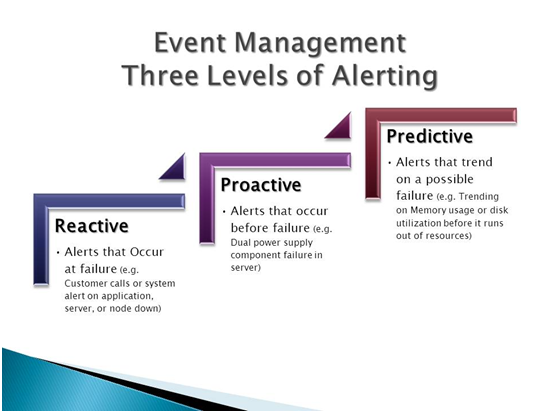Can Event management help foster a
curiosity for innovative possibilities to make application performance better? Blue-sky thinkers may not want to deal with
the myriad of details on how to manage the events being generated
operationally, but could learn something from this exercise.
Consider the major system
failures in your organization over the last 12 to 18 months. What if you had a system or process in place
to capture those failures and mitigate them from a proactive standpoint preventing
them from reoccurring? How much better
off would you be if you could avoid the proverbial "Groundhog Day” with system outages?
The argument that system monitoring is
just a nice to have, and not really a
core requirement for operational readiness, dissipates quickly when a critical
application goes down with no warning.
Starting with the Event
management and Incident management processes may seem like a reactive approach
when implementing an Application Performance Management (APM) solution, but is
it really? If "Rome is burning”,
wouldn’t the most prudent action be to extinguish the fire, then come up with a
proactive approach for prevention?
Managing the operational noise can calm the environment allowing you to
focus on APM strategy more effectively.

Asking the
right questions during a post-mortem review will help generate dialog,
outlining options for alerting and prevention.
This will direct your thinking towards a new horizon of continual
improvement that will help galvanize proactive monitoring as an operational
requirement. Here are three questions that
build on each other as you work to mature your solution:
1.
Did we alert on
it when it went down, or did the user community call us?
2.
Can we get a
proactive alert on it before it goes down, (e.g. dual power supply failure in
server)?
3.
Can we trend on
the event creating a predictive alert before it is escalated, (e.g. disk space utilization
to trigger a minor@90%, major@95%, critical@98%)?
The
preceding questions are directly related to the following categories respectively:
Reactive, Proactive, and Predictive.
Reactive – Alerts that occur at
failure
Multiple events can occur before a system failure; eventually an alert
will come in notifying you that an application is down. This will come from either the users calling
the Service Desk to report an issue or it will be system generated corresponding
with an application failure.
Proactive – Alerts that occur before
failure
These alerts will most likely come from proactive monitoring to tell you
there are component failures that need attention but have not yet affected
overall application availability, (e.g. dual power supply failure in server).
Predictive – Alerts that trend on a
possible failure
These alerts are usually set up in parallel with trending reports that
will help predict subtle changes in the environment, (e.g. trending on memory
usage or disk utilization before running out of resources).
Conclusion
Once you build awareness
in the organization that you have a bird’s eye view of the technical landscape and
have the ability to monitor the ecosystem of each application (as an ecologist),
people become more meticulous when introducing new elements into the
environment. They know that you are
watching, taking samples, and trending on the overall health and stability
leaving you free to focus on the strategic side of APM without
distraction.
Related Links:
For a high-level view of a
much broader technology space refer to slide show on BrightTALK.com which
describes "The Anatomy of APM-
Webcast” in more context.
For more information on the critical success factors in APM
adoption and how this centers around the End-User-Experience (EUE), read The Anatomy of APM and the corresponding blog APM’s DNA – Event to
Incident Flow.
Prioritizing Gartner's APM Model
APM and MoM – Symbiotic Solution Sets